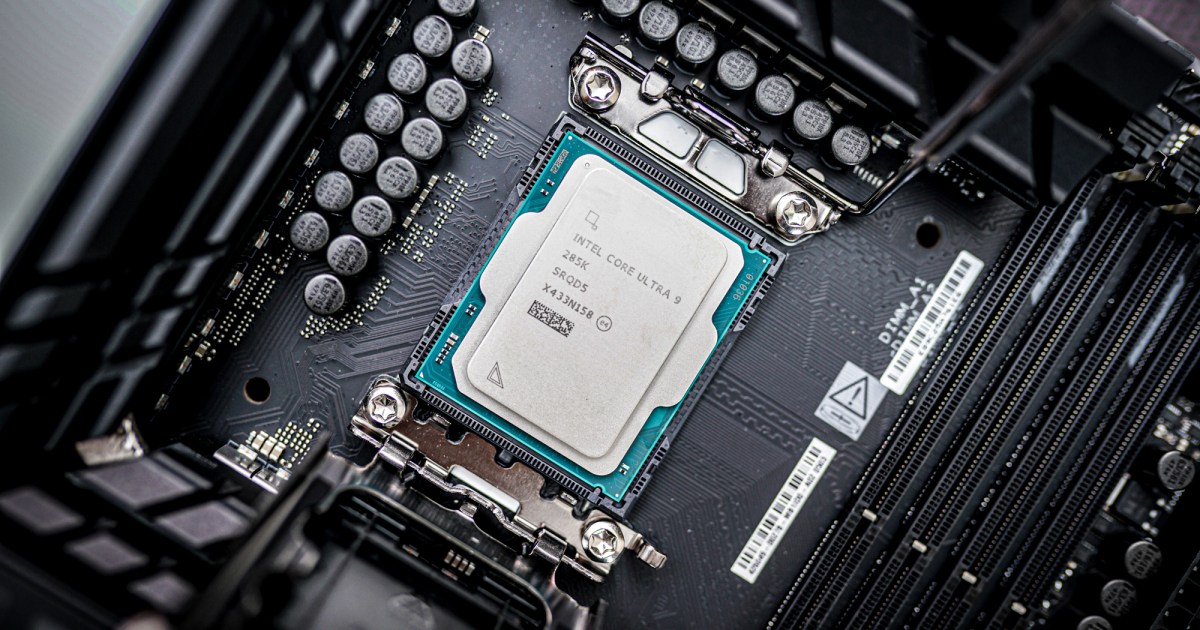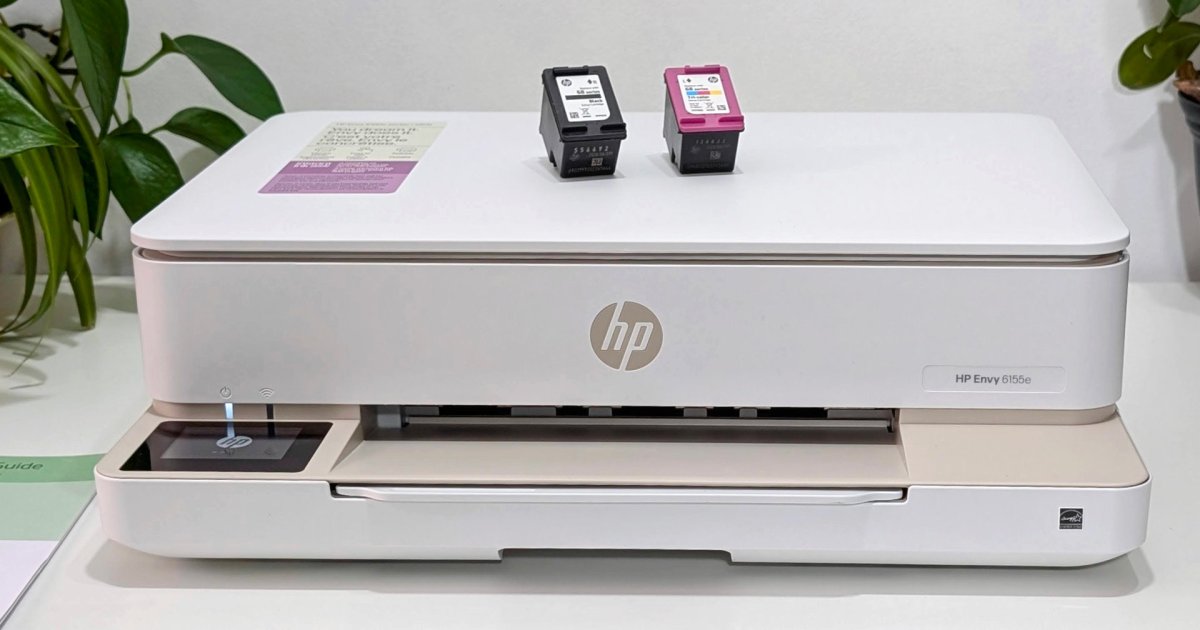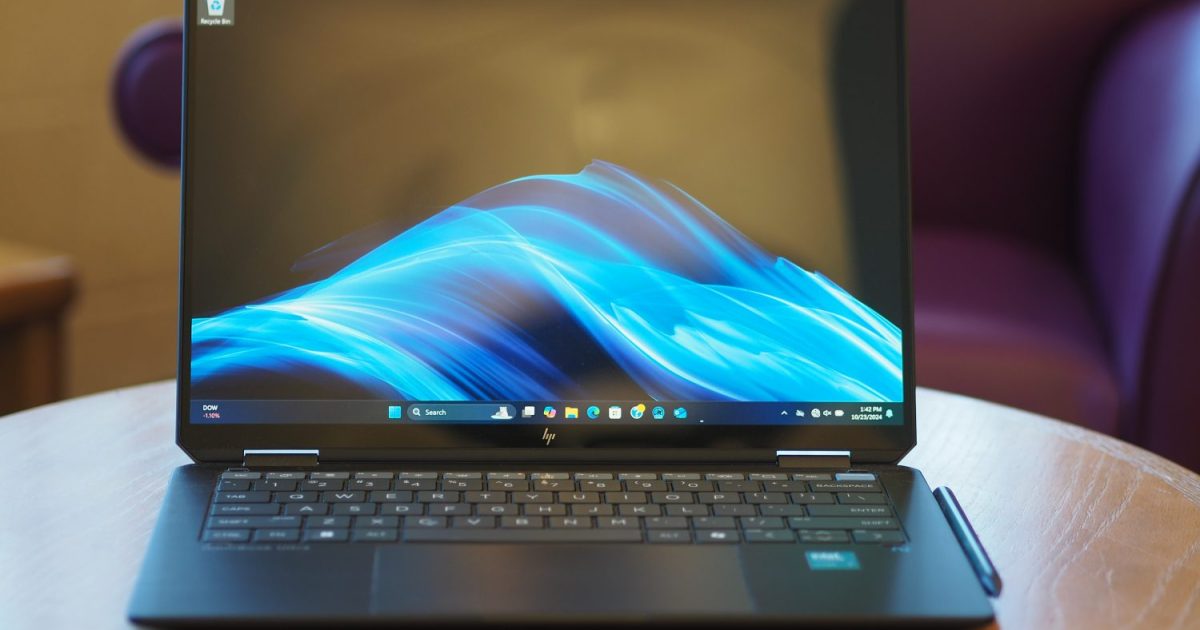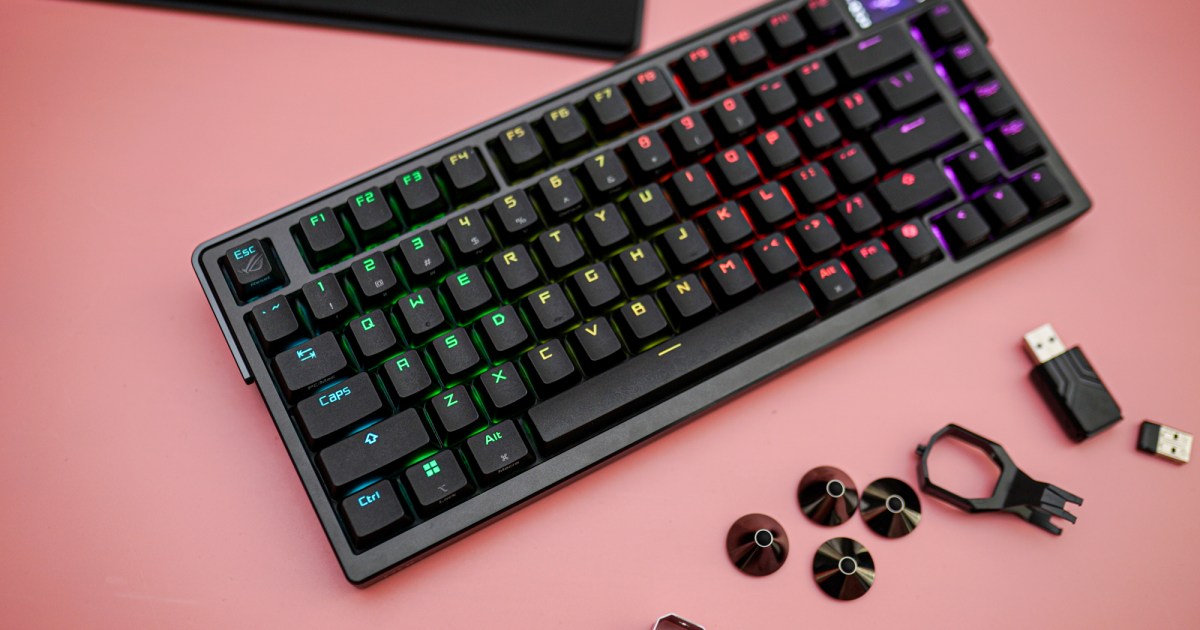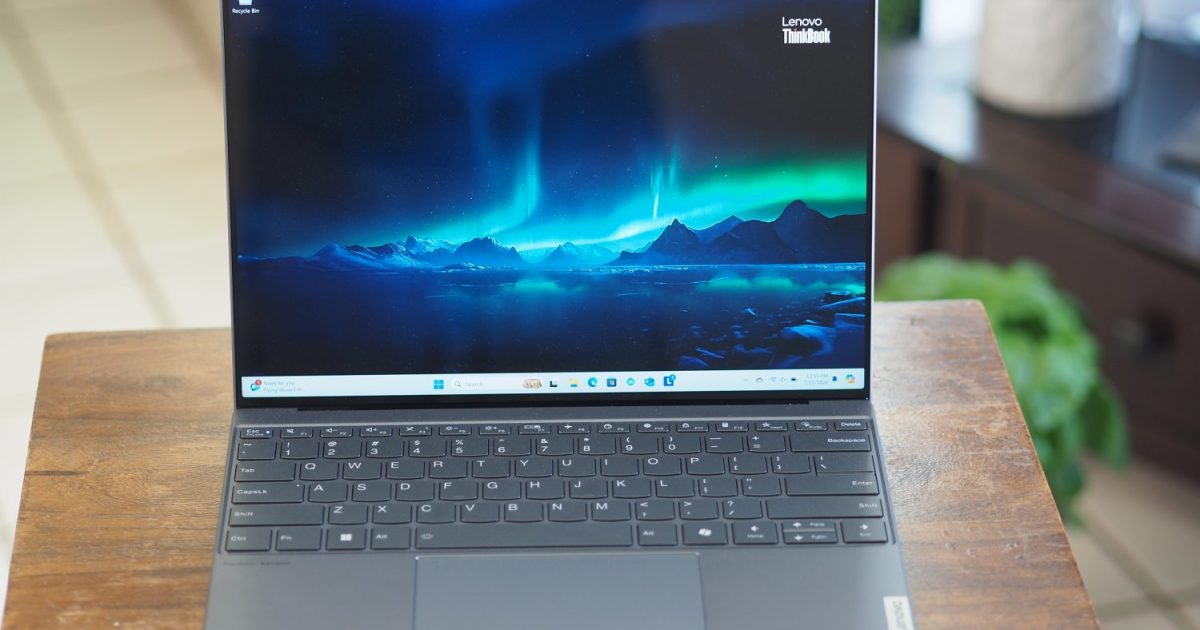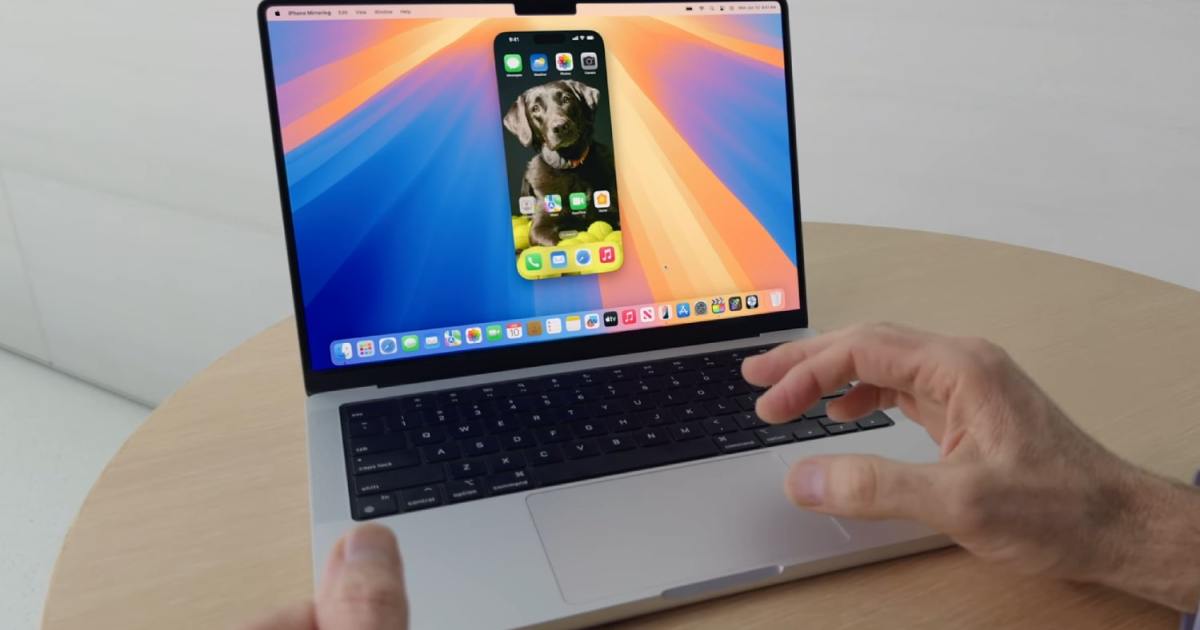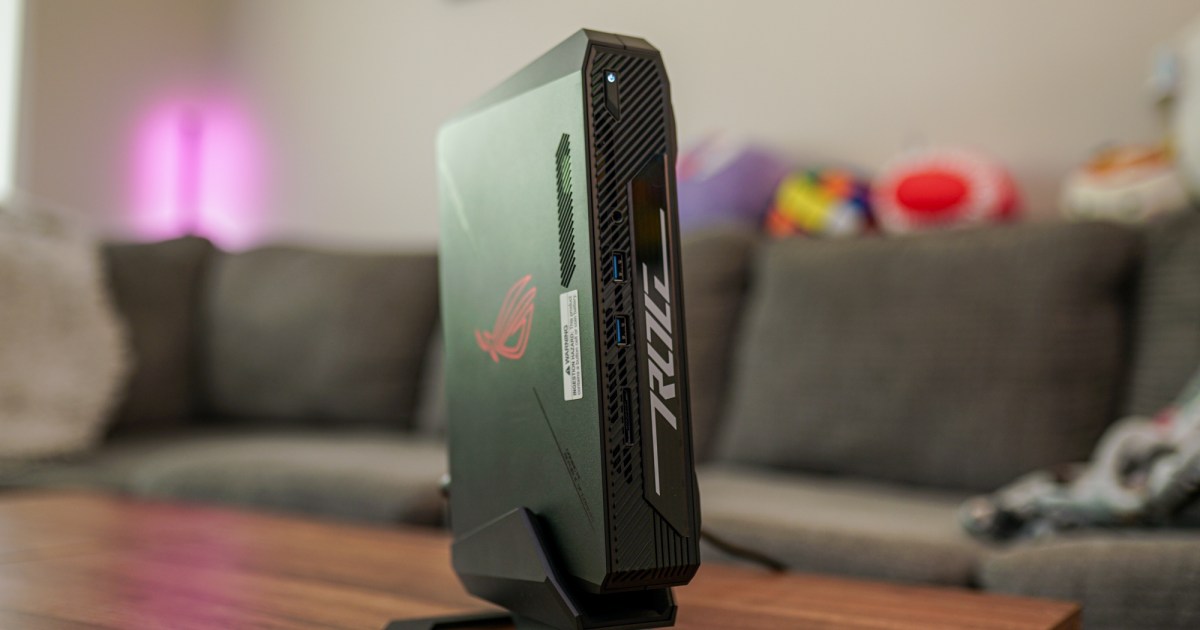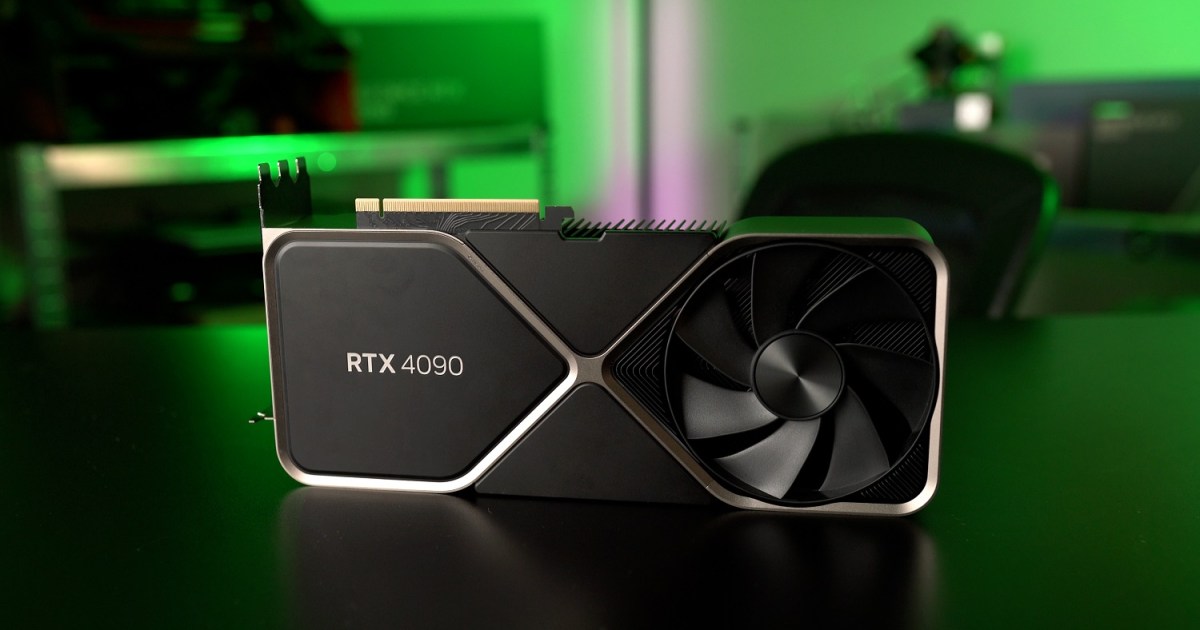The Core Ultra 9 285K is a radical departure for Intel, representing a complete overhaul in CPU design and features. Focused on efficiency, this new desktop processor delivers performance improvements that seem almost magical compared to CPUs from the past decade. However, despite its impressive capabilities, recommending the Core Ultra 9 285K for purchase is surprisingly difficult.
Intel Core Ultra 200S Overview
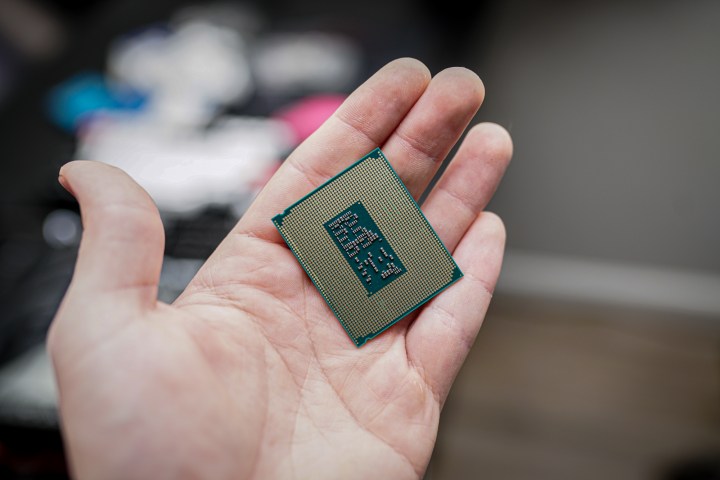 alt text: Rear view of the Intel Core Ultra 9 285K CPU
alt text: Rear view of the Intel Core Ultra 9 285K CPU
At first glance, the Core Ultra 200S series (formerly Arrow Lake) appears similar to 12th, 13th, and 14th-gen Intel CPUs. Core counts and power draw remain comparable, with clock speeds only slightly reduced. However, the specifications don’t tell the whole story of this revolutionary chip.
The Core Ultra 9 285K eliminates Hyper-Threading, meaning one core equals one thread. This contrasts with decades of two threads per core, putting the 285K at a thread disadvantage against competitors like the Ryzen 9 9950X. To compensate, Intel has significantly enhanced individual core power.
Unlike previous hybrid architectures, the 285K’s E-cores drive baseline performance, while P-cores handle intense, single- or dual-threaded workloads. This innovative design improves efficiency, which benchmark results will highlight.
| Feature | Core Ultra 9 285K |
|---|---|
| Cores (P+E) / Threads | 24 (8+16) / 24 |
| Base Clock (P/E) | 3.7GHz / 3.2GHz |
| Boost Clock (P/E) | 5.7GHz / 4.6GHz |
| Total Cache (L2+Smart Cache) | 60MB |
| Power (Base/Max) | 125W/250W |
Mirroring Intel’s Lunar Lake mobile CPUs, the Core Ultra 200S boasts higher core counts, clock speeds, cache, and power limits. The Skymont E-cores reportedly offer a 2% IPC improvement over the Raptor Cove P-cores in previous generations. Furthermore, the Core Ultra 285K is Intel’s first desktop CPU manufactured by TSMC, utilizing the N3B node. Lastly, it includes an integrated 13 TOPS NPU, a feature whose desktop relevance remains to be seen.
Test Setup and Compatibility
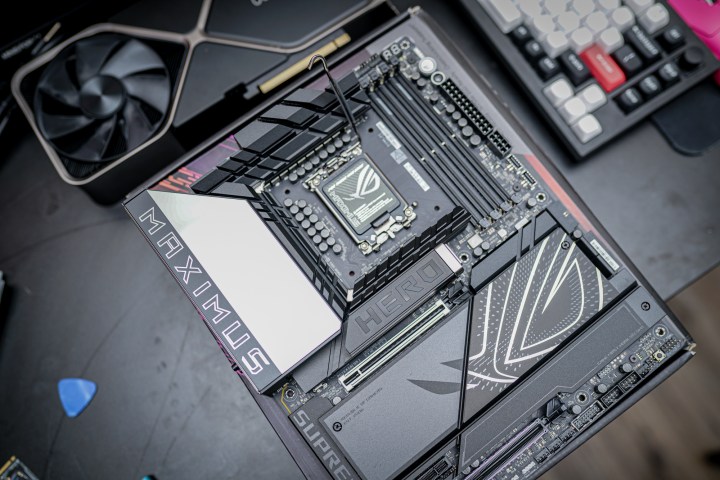 alt text: Asus ROG Maximus Hero Z890 motherboard
alt text: Asus ROG Maximus Hero Z890 motherboard
Testing was conducted on nearly identical systems for Arrow Lake, Zen 5, Zen 4, and Raptor Lake processors, changing only the CPU and motherboard. An RTX 4080 and DDR5-6000 RAM were used to isolate CPU performance. The high-end Asus ROG Maximus Z890 Hero motherboard was selected after encountering boot issues with an MSI board, likely due to pre-release BIOS versions.
| Component | Details |
|---|---|
| GPU | Nvidia RTX 4080 Founders Edition |
| RAM | 32GB Gigabyte Aorus DDR5-6000 |
| Motherboard | Asus Z890 ROG Maximus Hero |
| CPU Cooler | MSI CoreLiquid i360 |
| Storage | Boot: Samsung 990 Pro 2TB / Tests: MSI M450 1TB |
The Core Ultra 9 285K uses the new LGA 1851 socket. While physically similar to the LGA 1700, it lacks backward compatibility. Existing LGA 1700 coolers are compatible with the LGA 1851 socket, though an offset bracket, like the one included with the MSI MAG CoreLiquid i360, is recommended for optimal cooling due to the higher hotspot location on Arrow Lake chips.
Productivity Performance
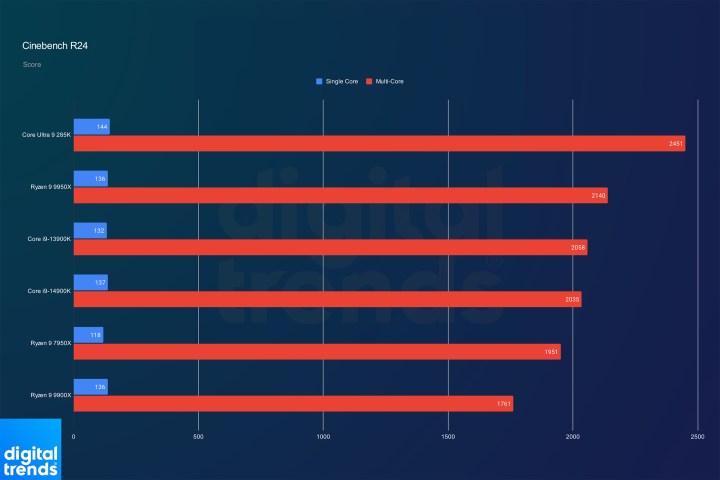 alt text: Cinebench R24 benchmark results for the Core Ultra 9 285K.
alt text: Cinebench R24 benchmark results for the Core Ultra 9 285K.
The Core Ultra 9 285K delivers impressive performance. In Cinebench R24, it outperforms the Ryzen 9 9950X by 15% and the Core i9-14900K by 20% in multi-core performance, despite having fewer threads (24 vs. 32).
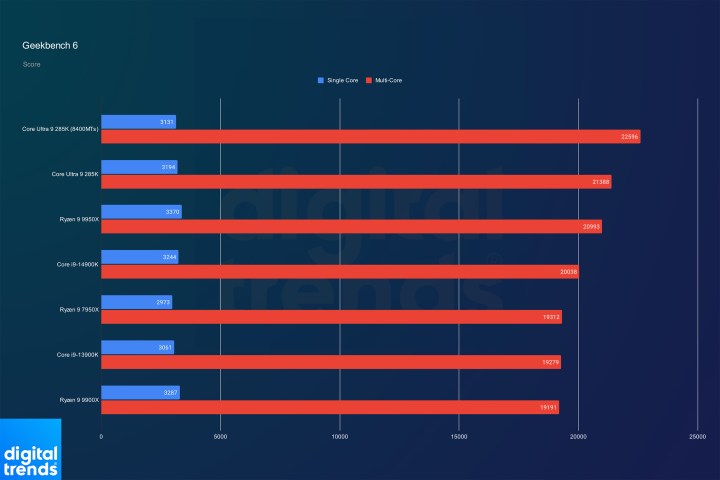 alt text: Geekbench 6 benchmark results for the Core Ultra 9 285K
alt text: Geekbench 6 benchmark results for the Core Ultra 9 285K
Geekbench 6 shows a slight single-core performance decrease compared to the Ryzen 9 9950X and Core i9-14900K, but the 285K still leads in multi-core performance, especially when paired with faster memory.
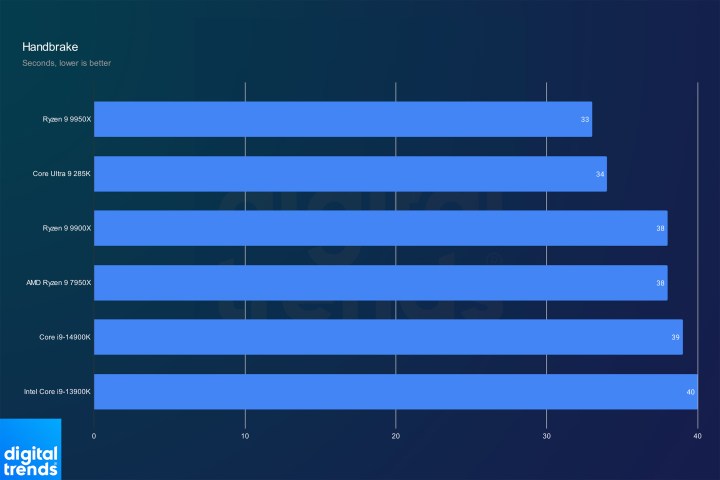 alt text: Handbrake benchmark results for the Core Ultra 9 285K.
alt text: Handbrake benchmark results for the Core Ultra 9 285K.
In Handbrake x265 video transcoding, the 285K performs almost identically to the Ryzen 9 9950X, a commendable result considering the generational difference.
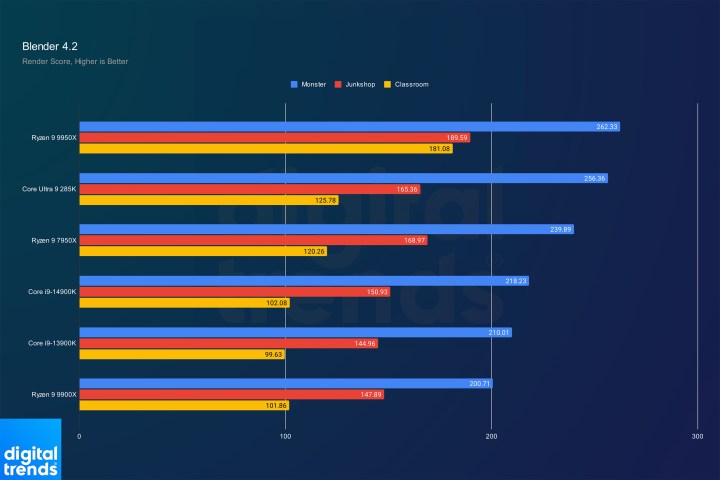 alt text: Blender benchmark results for the Core Ultra 9 285K.
alt text: Blender benchmark results for the Core Ultra 9 285K.
While the 285K significantly improves rendering performance compared to the Core i9-14900K in Blender, the Ryzen 9 9950X retains a noticeable edge.
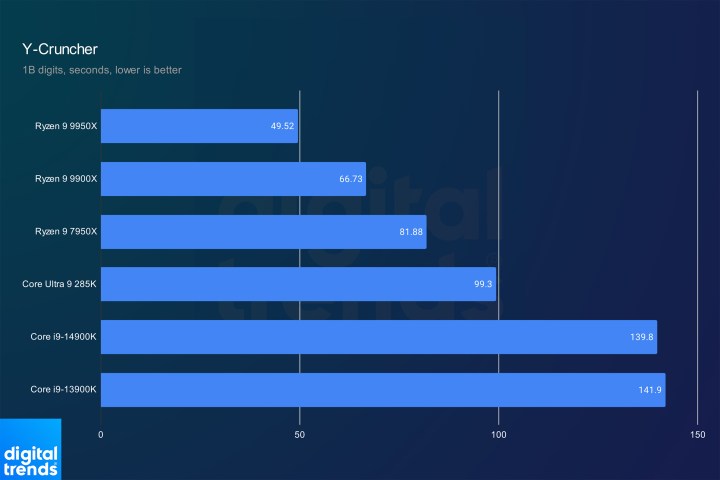 alt text: Y-Cruncher benchmark results for the Core Ultra 9 285K.
alt text: Y-Cruncher benchmark results for the Core Ultra 9 285K.
The Core Ultra 9 285K lacks AVX-512 support. While irrelevant for most users, applications utilizing AVX-512 instructions will see substantial benefits with Zen 5 CPUs. Y-Cruncher highlights this disparity.
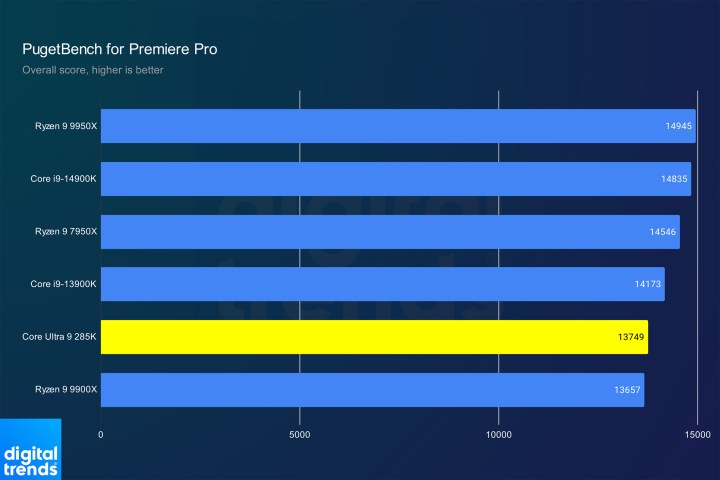 alt text: Adobe Premiere Pro benchmark results for the Core Ultra 9 285K.
alt text: Adobe Premiere Pro benchmark results for the Core Ultra 9 285K.
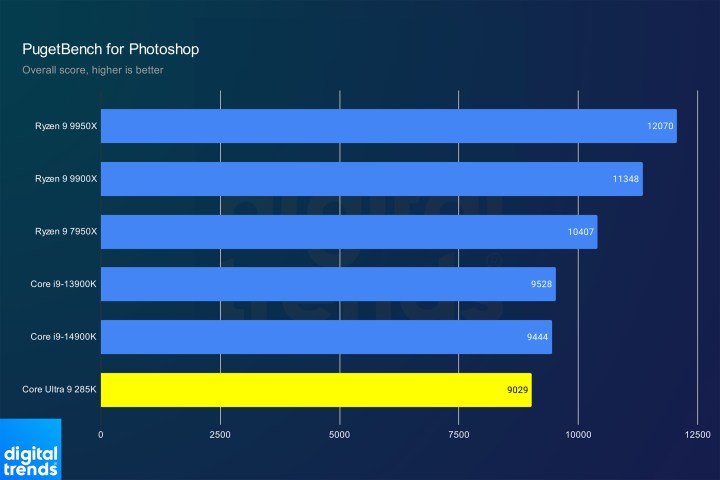 alt text: Adobe Photoshop benchmark results for the Core Ultra 9 285K.
alt text: Adobe Photoshop benchmark results for the Core Ultra 9 285K.
Disappointingly, the 285K underperforms in Adobe Premiere Pro and Photoshop, trailing behind older CPUs like the Core i9-13900K and Ryzen 9 7950X. Extensive testing with various hardware and software configurations confirmed these results.
Gaming Performance
Intel aimed to maintain, not improve, gaming performance with the Core Ultra 9 285K. Based on tests across 10 games, it performs on par with or slightly slower than the Core i9-14900K, and significantly lags behind AMD’s Ryzen 7 7800X3D.
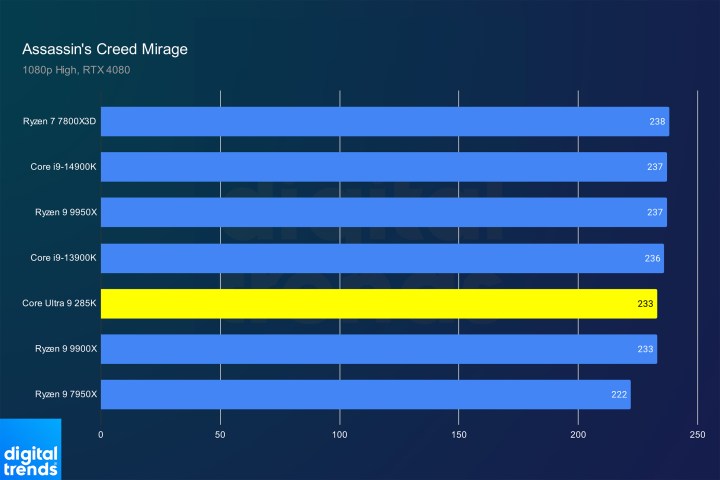 alt text: Assassin's Creed Mirage benchmark results for the Core Ultra 9 285K.
alt text: Assassin's Creed Mirage benchmark results for the Core Ultra 9 285K.
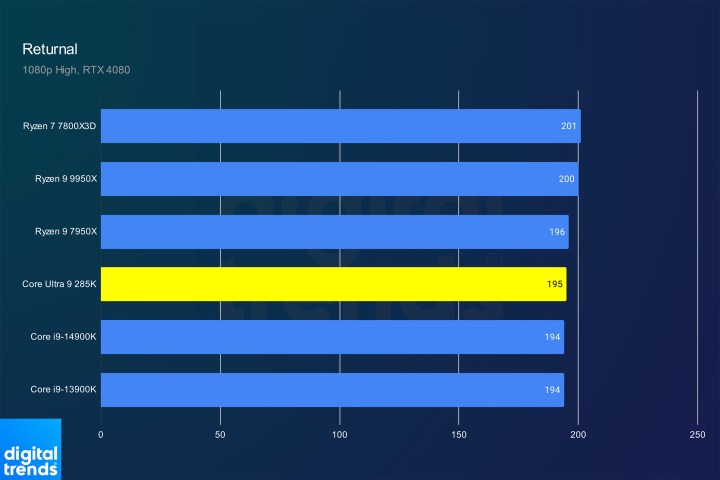 alt text: Returnal benchmark results for the Core Ultra 9 285K.
alt text: Returnal benchmark results for the Core Ultra 9 285K.
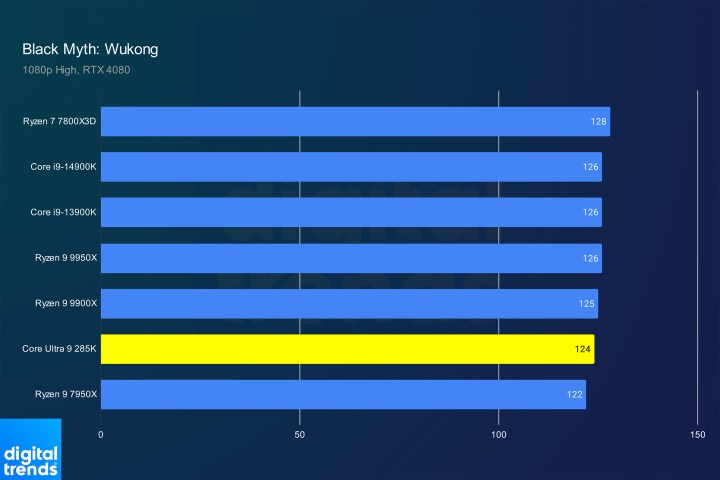 alt text: Black Myth: Wukong benchmark results for the Core Ultra 9 285K.
alt text: Black Myth: Wukong benchmark results for the Core Ultra 9 285K.
In GPU-bound titles like Returnal, Assassin’s Creed Mirage, and Black Myth: Wukong, performance differences are minimal at 1080p High settings. However, the Ryzen 7 7800X3D maintains its lead, reinforcing its position as the top gaming CPU.
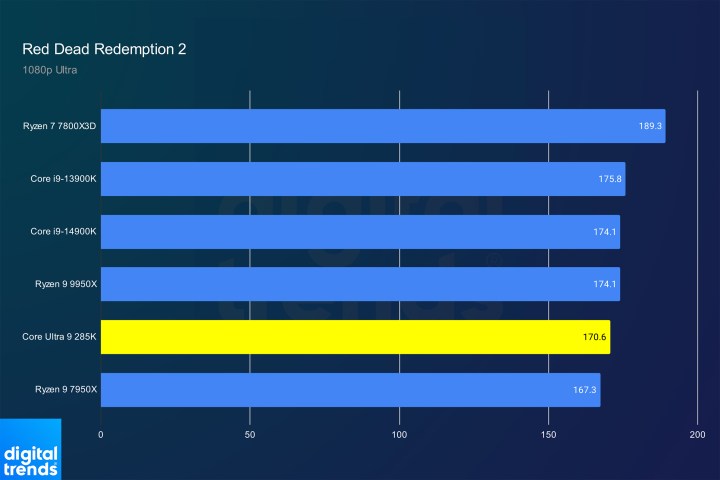 alt text: Red Dead Redemption 2 benchmark results for the Core Ultra 9 285K.
alt text: Red Dead Redemption 2 benchmark results for the Core Ultra 9 285K.
Even in graphically demanding games like Red Dead Redemption 2, the Ryzen 7 7800X3D significantly outperforms the competition.
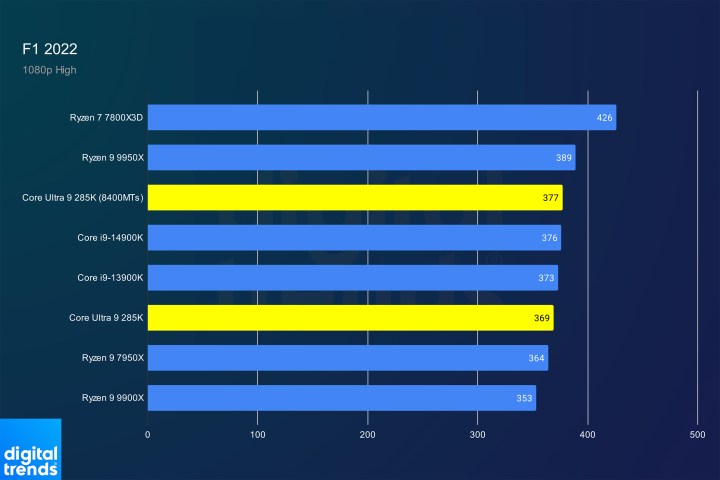 alt text: F1 22 benchmark results for the Core Ultra 9 285K.
alt text: F1 22 benchmark results for the Core Ultra 9 285K.
In F1 22 and Final Fantasy XIV, the 285K benefits from faster DDR5 RAM, though it still trails behind AMD’s Ryzen 9 9950X and Ryzen 7 7800X3D.
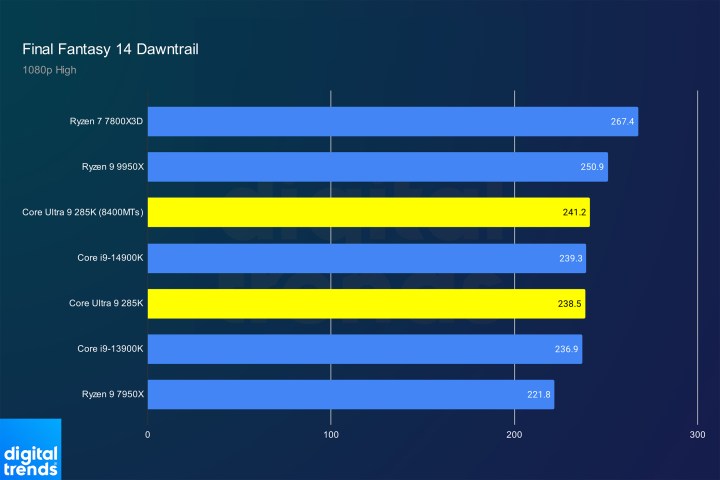 alt text: Final Fantasy 14 benchmark results for the Core Ultra 9 285K.
alt text: Final Fantasy 14 benchmark results for the Core Ultra 9 285K.
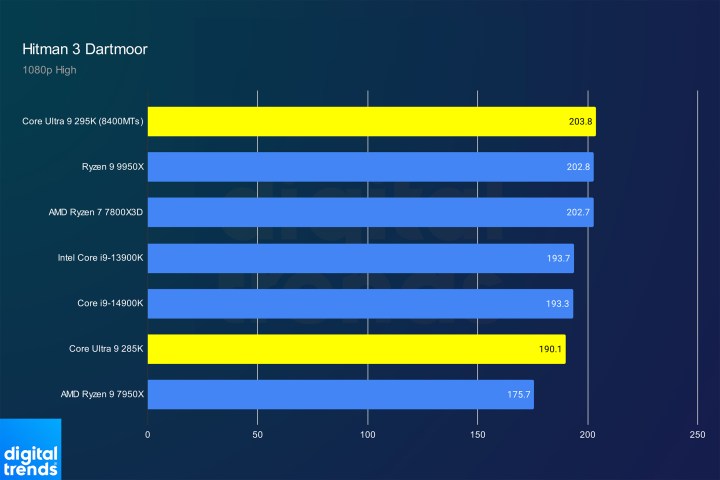 alt text: Hitman 3 benchmark results for the Core Ultra 9 285K.
alt text: Hitman 3 benchmark results for the Core Ultra 9 285K.
Hitman 3 is the only title where the Core Ultra 9 285K leads, albeit marginally and with faster memory.
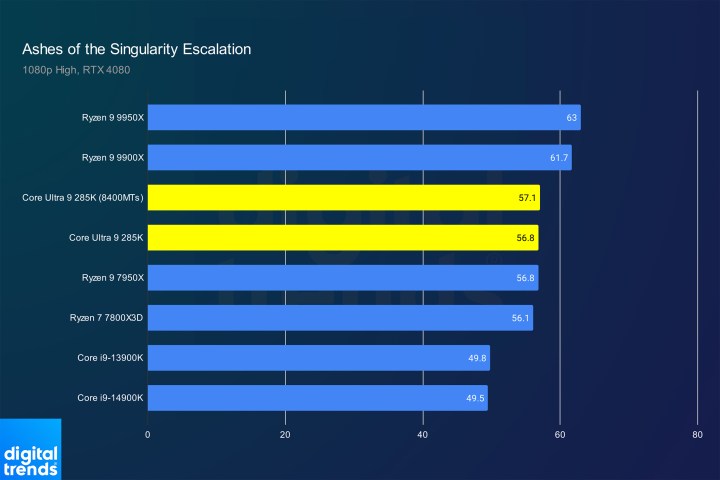 alt text: Ashes of the Singularity benchmark results for the Core Ultra 9 285K.
alt text: Ashes of the Singularity benchmark results for the Core Ultra 9 285K.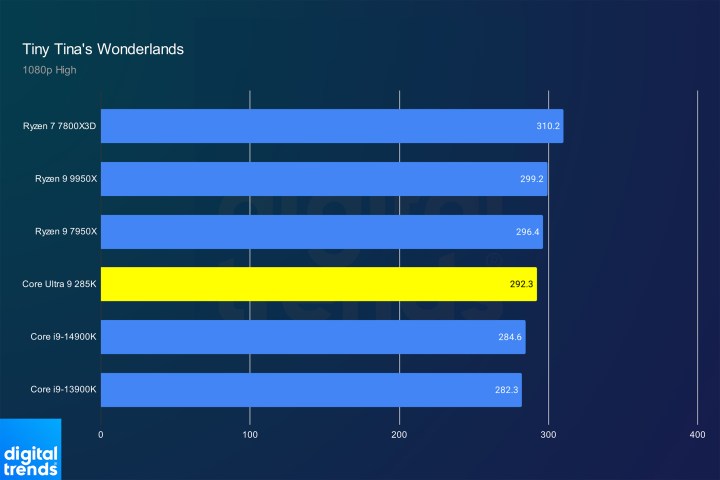 alt text: Tiny Tina's Wonderlands benchmark results for the Core Ultra 9 285K.
alt text: Tiny Tina's Wonderlands benchmark results for the Core Ultra 9 285K.
Some generational improvements are evident in Ashes of the Singularity and Tiny Tina’s Wonderlands. However, AMD’s offerings consistently outperform the 285K in gaming, highlighting Intel’s strategic shift away from prioritizing gaming performance.
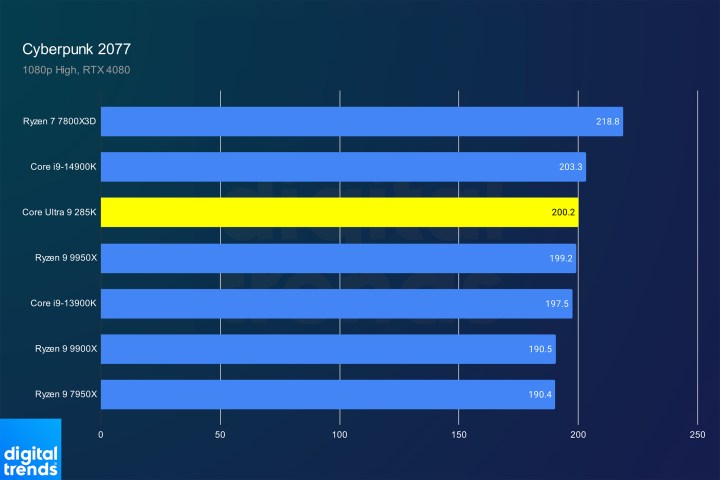 alt text: Cyberpunk 2077 benchmark results for the Core Ultra 9 285K.
alt text: Cyberpunk 2077 benchmark results for the Core Ultra 9 285K.
Cyberpunk 2077 results reinforce the observed trend.
Temperatures and Power
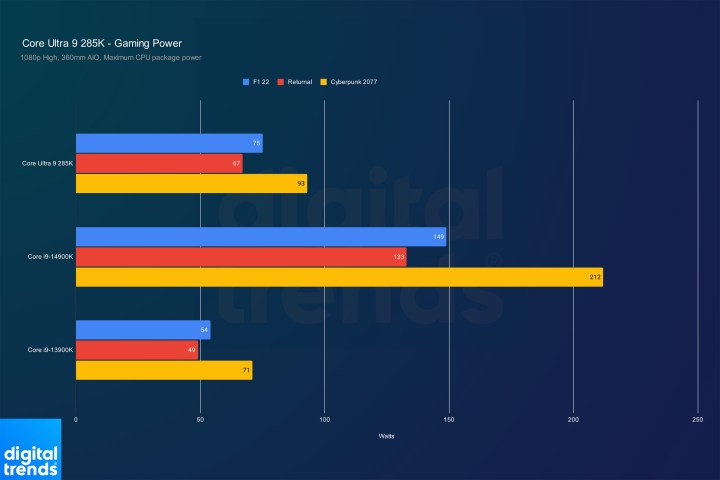 alt text: Power consumption comparison for the Core Ultra 9 285K.
alt text: Power consumption comparison for the Core Ultra 9 285K.
The Core Ultra 9 285K delivers impressive efficiency improvements. While offering comparable performance, its power consumption is often 50% lower than previous generations. However, the Ryzen 7 7800X3D still provides superior performance at an even lower power draw.
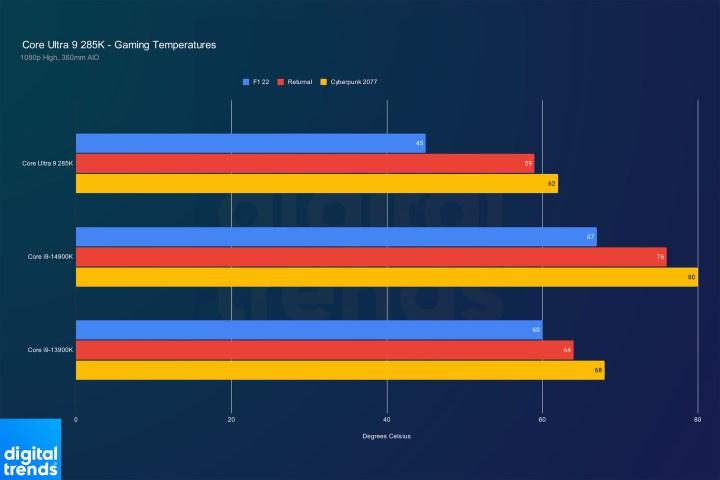 alt text: Temperature comparison for the Core Ultra 9 285K.
alt text: Temperature comparison for the Core Ultra 9 285K.
Despite consuming more power, the Core Ultra 9 285K runs cooler. This advantage could be crucial in thermally constrained small form factor PCs.
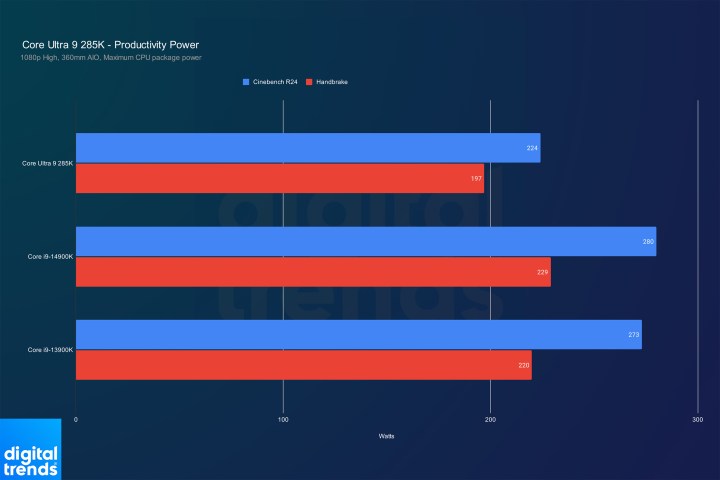 alt text: Power consumption in productivity applications for the Core Ultra 9 285K.
alt text: Power consumption in productivity applications for the Core Ultra 9 285K.
Efficiency gains are particularly significant in gaming. In productivity workloads like Cinebench and Handbrake, the 285K offers both performance and efficiency improvements.
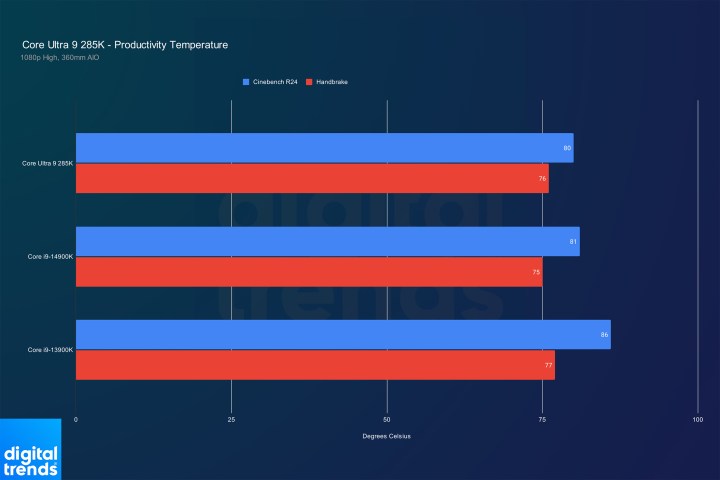 alt text: Temperature in productivity applications for the Core Ultra 9 285K.
alt text: Temperature in productivity applications for the Core Ultra 9 285K.
While temperature differences in productivity applications are less pronounced, they become more significant in thermally restricted environments.
Addressing Instability Concerns
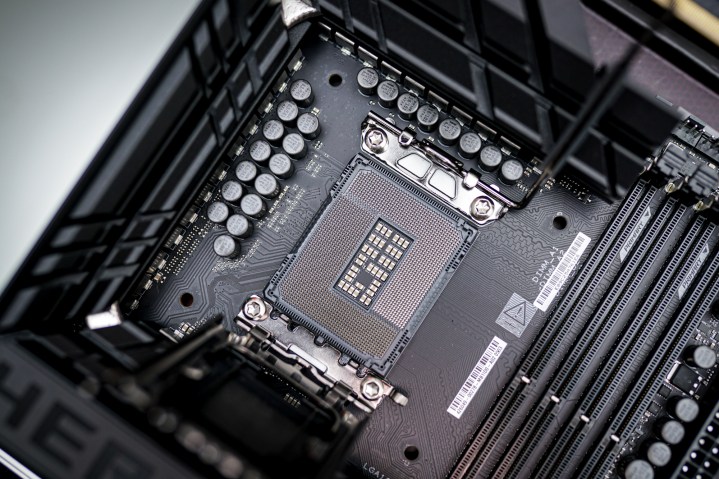 alt text: LGA 1851 socket on a motherboard.
alt text: LGA 1851 socket on a motherboard.
Given past instability issues with Intel CPUs, the company seems to be proactively addressing potential problems with the Core Ultra 9 285K. Z890 motherboards feature default power settings clearly labeled as Intel defaults. Intel has also enhanced communication with motherboard partners to ensure consistency and address any instability issues swiftly. While long-term stability can only be assessed over time, Intel appears committed to preventing widespread or persistent problems.
Should You Buy the Core Ultra 9 285K?
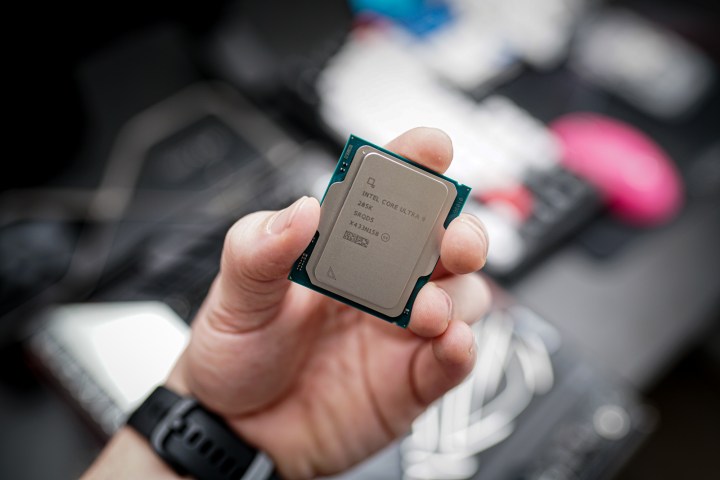 alt text: Holding the Core Ultra 9 285K CPU.
alt text: Holding the Core Ultra 9 285K CPU.
The Core Ultra 9 285K is undeniably impressive, showcasing Intel’s willingness to innovate. However, “impressive” doesn’t always translate to “good.”
For gamers, the 285K offers increased efficiency but not improved performance compared to the Core i9-14900K. AMD’s Ryzen 7 7800X3D and upcoming Ryzen 7 9800X3D remain superior choices for gaming.
In productivity tasks, the 285K trades blows with the Ryzen 9 9950X, though the latter demonstrates more consistent performance. Future software optimizations could improve the 285K’s standing.
The Core Ultra 9 285K finds a niche in small form factor PCs requiring a balance of productivity and gaming performance. However, for most users, other CPUs offer a more compelling value proposition.



